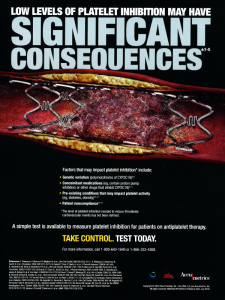February 27th, 2011
Examining an Ad for a Platelet-Inhibition Test
Harlan M. Krumholz, MD, SM
 I’ve recently seen in medical journals an advertisement that features an image of a clot within a stent and this headline in all capital letters: “Low Levels of Platelet Inhibition May Have Significant Consequences.” The final two words, “Significant Consequences,” are in a very large font, and the entire ad has an ominous black background.
I’ve recently seen in medical journals an advertisement that features an image of a clot within a stent and this headline in all capital letters: “Low Levels of Platelet Inhibition May Have Significant Consequences.” The final two words, “Significant Consequences,” are in a very large font, and the entire ad has an ominous black background.
Below the image is a bulleted list of “factors that may impact platelet inhibition”: genetic variation, concomitant medications, pre-existing conditions, and patient noncompliance. Each bullet point ends with numbered footnotes, with references appearing at the bottom of the ad.
The ad then asserts, “A simple test is available to measure platelet inhibition for patients on antiplatelet therapy.” In a larger font is the exhortation “TAKE CONTROL. TEST TODAY.”
The ad is jointly copyrighted by Daiichi Sankyo, Inc.; Lily USA; and Accumetrics. Accumetrics makes the test, and the two other companies co-developed and sell prasugrel, which inhibits platelet aggregation.
This ad clearly implies that testing for platelet inhibition is a strategy that reduces the risk for stent thrombosis. But is that really true?
What We Know
Studies have shown that thienopyridines (including clopidogrel and prasugrel) are antagonists to the P2Y12 adenosine diphosphate receptor, which is involved in platelet aggregation. As described in a 2010 ACCF/AHA clinical alert, clopidogrel is an inactive prodrug that must go through several steps to be transformed into an active metabolite. This change is mediated by the hepatic cytochrome P450 system. The relationship between clopidogrel and platelet aggregation varies among individuals, related to genes that regulate the cytochrome P450 system. In contrast, prasugrel is oxidized to its active form in a single CYP-dependent step, and its ability to inhibit platelets seems unrelated to genetic profiles associated with reduced function of the cytochrome P450 system.
What We Do Not Know
No study has shown that a strategy guided by platelet aggregation testing produces better outcomes for patients. We know that a head-to-head comparison of clopidogrel with prasugrel in the TRITON-TIMI 38 study showed that prasugrel recipients had a slightly lower risk for cardiovascular events and a slightly higher risk for major bleeding, but the participants were not selected based on platelet-inhibition response to the drugs. The investigators have not published a study showing the results stratified by genetic profile or response to the drugs. Although platelet aggregation can predict outcomes, it is not known whether using a drug that is more consistent in its platelet inhibition will be better to reduce risk for adverse events. We know that some drugs seem to be superior because of their mechanism of action but fail to actually improve patient outcomes. So although it appears logical to use a test to select a drug that is successfully inhibiting platelet aggregation, the evidence to close that loop does not exist.
The aforementioned 2010 ACCF/AHA clinical alert states clearly: “The evidence base is insufficient to recommend either routine genetic or platelet function testing at the present time.”
I wish that information were also in large capital letters in the ad.

The Acumetrics test “Verfy Now” is not an accurate test because it detects only macro- an not micro-aggrergates. This is easily shown by doing a dose response curve using either Aggrestat, Reopro, or Integrelin as the inhibiting agent. If this is done one will find that after about 80% inhibition the test shows no response. The solution is very cheap and simple. Nanely doing an electronic platelet count before and after additin of a standard dose of ADP as the agonist. The % inhibition is then the count after the agonist/ the count before and agonist. If this test is used to do a dose response curve as indicated above, the response will be linear thoughout the entire range of inhibition. Such a test should be used after the first few doses of clopidogrel to identify patients with genetic defects producing no response to the test and to pick up drug interference. Such use could prevent many bleeding episodes and at least an occasional stent thrombosis. Clinical trials are only one type of evidence and not the ONLY form of evidence, They should not replsce common sense and understanding mechanisms of disease in the practice of medicine. B.AKottke MD,PhD,FACC, Emeritus Professor of Medicine, Mayo College of Medicine
Competing interests pertaining specifically to this post, comment, or both:
None except concern for our patients
A brilliant and irresponsible circumvention of FDA regualtions. Tests and maybe devices ( I am no expert on the rules) are not subject to the more rigorous ad standards for prescription drugs. Interestingly, the tests are financially covered by the government. So as a taxpayer, I contribute to the costs of such tests (like the KIF 6 gene test). But use of the tests could easily lead to harm. The annoying add depicted could lead ANY patient with a stent to get tested and carries a chance of switching that patient to prasugrel (a drug only tested in the ACS population). Such a drug change will not only cost us more money, but could very well cause net harm. Just like the KIF6 test may have deprived some patients of statins.